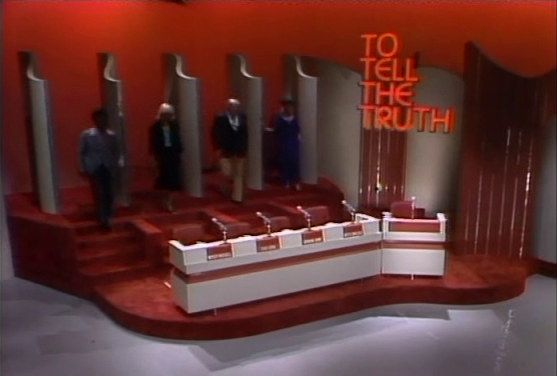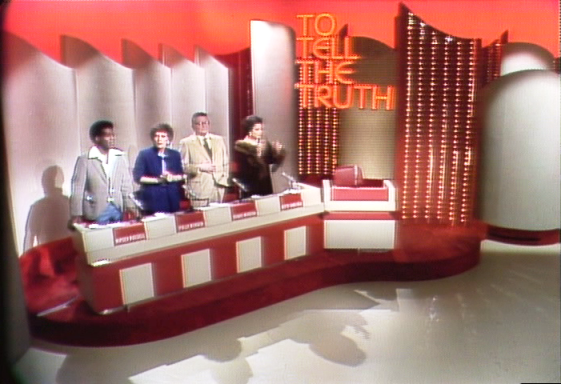To Tell The Truth
Series Three
195 shows produced between May 29, 1980 and April 16, 1981
Broadcast in syndication September 1980 through September 1981
Links: 1980-81 panel guide, 1980-81 crew list
By the time "To Tell The Truth"'s second version stopped rolling tape in 1978, Goodson-Todman Productions had logged nearly 4,000 individual shows since the program's 1956 pilot. Then just two years after the Garry Moore/Joe Garagiola version wrapped production, G-T updated "TTTT" to fit its vision of the new decade and breathed a third life into the durable format. Tapings began in Spring 1980 from familiar old NBC New York studios -- home to the previous series -- and continued to originate from either 6A or 8H each Thursday taping day thereafter. Hosting duties this time fell to actor Robin Ward, who boasted an excellent professional reputation after working on projects such as the syndicated Canadian series “The Starlost” and a north-of-the-border rendition of “What’s My Line?”.
Despite Ward's "TTTT" rookie status, his above-the-line program staff was anything but: Lloyd Gross and Mimi O’Brien returned as director and producer, respectively, while Gil Fates exec produced after officially missing out on the '70’s series fun (Bruno Zirato’s prior engagement producing “Face The Music” forced him to Skip The Truth). Like its immediate predecessor, “To Tell The Truth” ’80 featured two maingames per show and contestants with unusual jobs or dubious claims to fame. The game's object remained the same as always: four panelists questioned three contestants claiming to be the same person, then voted on which contestant was the genuine article. But the new series brought with it some format changes in that the game’s questioning rounds were accelerated and any demonstrations banished to the closing credits in favor of “One On One”, a third-round hybrid in which that show’s four impostors challenged the panel with a final vocation. In this segment, each panelist questioned one predetermined contestant only, then immediately voted whether the individual was fake or real deal. Then the next panelist would continue by interviewing the next challenger until each celebrity had questioned and voted on a single contestant. Faulty guesses in both this segment and the front game were worth $100 apiece, complete stumps $500.
Prolific designer Ronald Baldwin took another turn at the "TTTT" set. Baldwin’s long list of credits included the final backdrops for CBS’s “To Tell The Truth” and “I’ve Got A Secret”, the 1974 big-top overhaul of “What’s My Line?”, and those flashy “Electric Company” sets from its second season forward. Here he countered the previous " . . . Truth"’s dramatic cathedral motif with . . . a dance floor. Chaser lights, off-white furniture against a hazy red backdrop, and a mobile desk for the contestants gave this version a kinetic nightclub feel. But even with all those modifications, this set’s most noted features remain its clamshell entryways: automated individual doors for both contestants and panelists that replaced the traditional curtain.
It was the first time since 1959 – when the panelists last intoned their own “My name is . . ." introductions – that the show’s celebrities were placed on the same figurative level as the civilian players. But since the doors were located directly behind each player’s chair, viewers used to enjoying the panelists’ extended introductory walkons didn’t have much chance for people watching (until the midseason move from NBC studio 8-H to studio 6-A, when the panelists’ doors were bolted for good and the celebrities began bolting from the upstage cavity).


Both versions of the 1980 set are shown above. Note
that the studio 8-H backdrop (left) has clamshell doors that actually
open so the panelists could make
their entrances. After moving to studio 6-A (right), the stairs were removed
and the doors replaced by a scaled-down wall similar to the original doors.
|
As
described in the 1980 promotion kit, the TTTT 1980 set was intended
to have qualities that didn't quite translate: "Trimmed in
fiery red and flashing silver, the set, almost human in its scene-stealing
mastery, caused some of the panelists to cry menacingly, 'Get that
set off the set.' This was one time the panelists definitely did
not ask a question!" But on the small screen, what actually
came across somehow was a dingy, neglected sub-basement.
|
An updated title logo came in the form of a stacked, red tubular neon jobbie, but " . . . Truth" 1980 displayed neither the familiar "TTTT" man nor his crossed-fingers trademarks, making it the only version to date not to employ at least one of Georg Olden’s original series insignias.
In contrast to the CBS and syndicated series before it, the 1980 “To Tell The Truth” went into production with no regular panel and never settled on one, instead featuring a succession of rotating players. During the Moore series, the occasional shuffling of the established panel's seating order had the term panel rotation implying little more than musical chairs. With TTTT '80, panel rotation connoted a well-worn revolving door: during 39 weeks of 1980-81 programs, no single panel of four celebrities duplicated itself. Soupy Sales clocked in most often (21 weeks), followed by Kitty Carlisle (17), Nipsey Russell (16), Peggy Cass (11), and Pat Collins (11). The venerable Carlisle-Cass-Cullen trio never appeared together in this series, although there were two Cass/Cullen weeks and one Carlisle/Cass week. New panelists this season included Susan Lucci, “Eight Is Enough”’s Lani O’Grady, Tiiu Leek, and critic Joel Siegel. Notably absent were Orson Bean, Tom Poston, and Gene Shalit, but original panelist Polly Bergen did return for several weeks’ worth of tapings. The contestant side of the stage this season saw celebrity or celebrity-to-be visits from Rosa Parks, John McLaughlin, "Leave It To Beaver"'s Ken Osmond, astronaut Gordon Cooper, "Tic Tac Dough" champion Thom McKee, "Father Knows Best"'s kitten Lauren Chapin, and future CNN interviewer Larry King.
Many shortcomings contributed to the third " . . . Truth"'s swift demise. Robin Ward made for an adequate if awk-Ward host who paled without the impish warmth of showman Garry Moore or the jock appeal of everyman Joe Garagiola, both of whom were barely out of reruns and still fresh in viewers' memories. The rotating panel concept made for an old pro/new kid approach to almost every show, and yet there were weeks when the panel didn’t balance, largely when compared against the Triple C threat of the old show. Then there was a jarringly noticeable change in tone. The looser format of the 1969-78 series had featured two games followed by maybe a demo or longer contestant interview or witty panel chat, and certainly struck a watchable blend of fun romp within the gameplay. Not this venture, which was edited within an inch of its footlong life. Virtually every conversation opportunity got squeezed out to make room for the One On One segment. It was down to business again, à la the CBS series . . . but this time poiseless.
From the start, " . . . Truth" 1980 was in the unenviable position of following two successful extended performances. Although the game's format remains among the simplest and strongest, TV can be cyclical, and in 1980 panel shows were really only just hanging in there. Combining that fact with its mediocre host and inconsistent panel, this " . . . Truth"'s survival chances were never terrific. So despite the pedigree, the show finished its taping season in April 1981 after having produced the standard 39 weeks, by which time it had already been demoted in some markets from prime-time access to less competitive morning and midday timeslots. By September, "To Tell The Truth" had quietly fizzled from the airwaves altogether.
Closed book . . . that didn’t get reread for another decade .
Bibliography
TV
Guide Magazine, various local editions. Triangle Publications. Radnor,
PA: 1980-81.
To Tell the Truth promotion kit. Viacom Enterprises. New York,
NY: 1980.
Back
to TTTT mainpage
Copyright ©
2003-24 by Marshall Akers
Revised 07/24/11